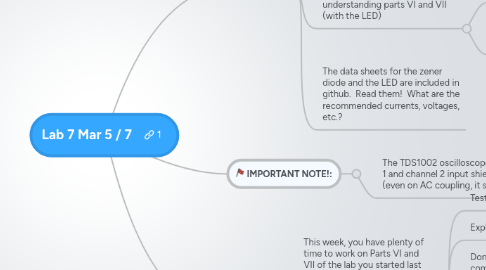
1. Goals
1.1. This week, you have plenty of time to work on Parts VI and VII of the lab you started last week. The main goal is to explore the circuit a lot and try to understand what is going on!
1.1.1. Test various currents, voltages
1.1.2. Explore different components
1.1.3. Don't worry about frying a component if it is cheap (e.g. a diode)
1.1.4. Take great notes, pictures, write down your insights
1.1.4.1. Take lots of notes. This isn't going to be get result and write "I got result..." you will need to write down what you did, how you did it, and what you learned.
1.2. A good way of knowing whether you have learned a lot from this lab is: Could you recreate the circuit from your mind? Could you tweak the circuit to make the LED brighter, dimmer, etc.? What is stabilized, current, voltage?
1.2.1. I (Steve) feel like I didn't understand a lot of this until I played around with it for several hours. So, that's the point of the lab session
2. Steps
2.1. Pick up from where you left off...
2.2. Download updated folder (photos) from github.
2.2.1. How do you do this? Not exactly sure, figure it out from git bash. Maybe "pull?" Make sure you're in the right local directory before you try to pull the new stuff down.
2.3. Spend a lot of time understanding parts VI and VII (with the LED)
2.3.1. Measure voltages, use a multimeter to measure currents, try out different resistors, etc.
2.3.2. This is a great lab to merge theory and experiment so go back to your basic circuit equations and plug in some numbers and test out your results.
2.4. The data sheets for the zener diode and the LED are included in github. Read them! What are the recommended currents, voltages, etc.?
3. IMPORTANT NOTE!:
3.1. The TDS1002 oscilloscope connects the channel 1 and channel 2 input shields directly to ground (even on AC coupling, it seems).
3.1.1. SOOO: When doing the full-wave bridge, you cannot use the oscilloscope to measure the waveform across the 1-Kohm resistor, because you will draw huge current.
